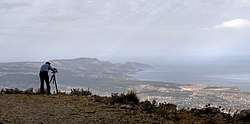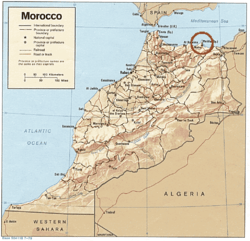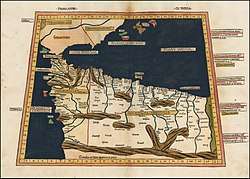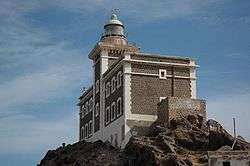Cape Three Forks
Cape Three Forks or Cape Tres Forcas is a headland on the Mediterranean coast of northeastern Morocco.


Geography
The cape is a large mountainous promontory of North Africa into the Mediterranean Sea. For centuries, this cape has provided both a nautical landmark and a maritime hazard for ships in the Alboran Sea. The Spanish exclave of Melilla surrounds a smaller cape on the eastern side of the peninsula.
Names

In antiquity, the cape was known to the Phoenicians and Carthaginians as Rusadir (Punic: 𐤓𐤔𐤀𐤃𐤓, ršʾdr),[1] giving its name to a nearby port (now Melilla). The name meant "Powerful"[2] or "High Cape",[3] but can also be understood as "Cape of the Powerful One", in reference to Baal, Tanit, and other important Punic god.[4][5] It was known to the Romans as Cape Metagonites (Latin: Metagonites Promontorium).[6][7]
Cape Three Forks is known in Spanish as Cabo de Tres Forcas, in French as Cap des Trois Fourches, and in Arabic as Ras Tleta Madari, all meaning "Cape of the Three Forks".
It is also known in Arabic as Ras Uarc.[8]
History
On 26 August 1923 the Spanish battleship España ran aground and eventually wrecked on the cape.
Lighthouse

A lighthouse is located in the north end of the cape. It is a gray tower on white two-story dwelling.
Ecology
| Designations | |
|---|---|
| Official name | Cap des Trois Fourches |
| Designated | 15 January 2005 |
| Reference no. | 1473[9] |
Cape Three Forks is a Ramsar designated site with no. 1473. It hosts different species, some of them threatened, such as the monk seal, two species of limpets (Patella ferruginea and Patella nigra), the Loggerhead turtle, the Fin whale and two species of dolphin (Tursiops truncatus and Delphinus delphis). The main activities taking place in the area are fishing and tourism.[10]
References
Citations
- Head & al. (1911), p. 889.
- Mora Serrano (2011), p. 25.
- Cath. Enc. (1913), s.v. "Rusaddir".
- Juárez, Roberto (3 September 2016), "Significado de Rusaddir", Melilla: Ciudad Desconocida. (in Spanish)
- López Pardo (2005), pp. 137–8.
- Ptol., Geogr., Bk. IV, Ch. i, §12.
- Dict. Gr. & Rom. Bio. & Myth. (1870), s.v. "Rusadir".
- "Melilla", North Africa, P502, NI 30-3, Washington: U.S. Army Map Service, 1953.
- "Cap des Trois Fourches". Ramsar Sites Information Service. Retrieved 25 April 2018.
- Ramsar Convention (2005-06-28). "The Annotated Ramsar List: Morocco". Archived from the original on 2013-01-07.
Bibliography
- James, Edward Boucher (1870), "Rusadir", Dictionary of Greek and Roman Biography and Mythology, Vol. III, Boston: Little, Brown, & Co.
- López Pardo, Fernando (2005), "La Fundación de Rusaddir y la Época Púnica", Historia de Melilla, Colección Historia de Melilla, No. 17, Melilla, pp. 167–189. (in Spanish)